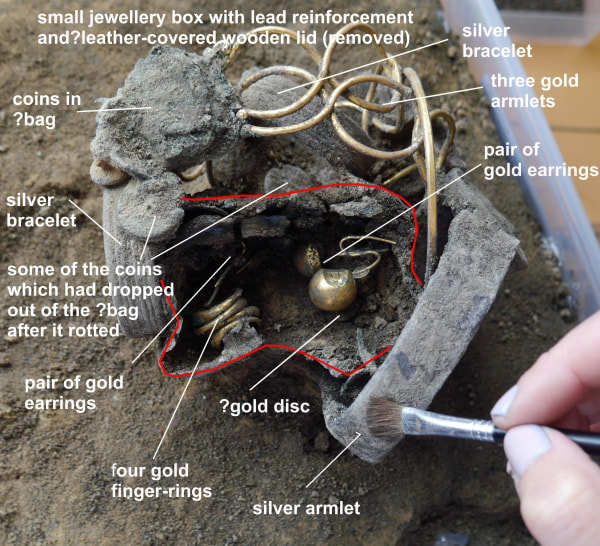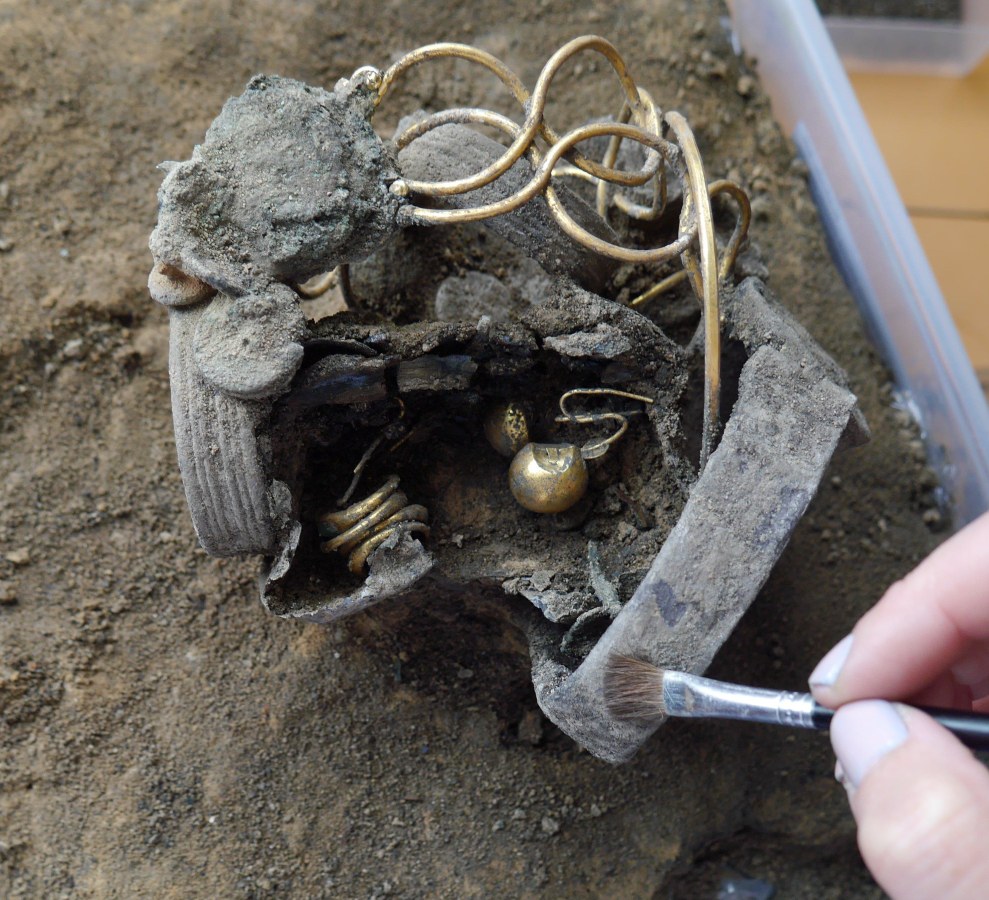More wired than a Roman Internet café
Ancient Roman Woman's Jewelry Found Under Department Store
Imagine the angst that a rich Roman woman must have felt in the year 61 when she had to abandon her gold and silver jewelry, buried beneath the floor of a house in the British town of Colchester. Almost two millennia later, those treasures have been unearthed at last — thanks to a dig at a department store that sells the 21st-century equivalents.
The hoard includes three gold armlets, a silver chain necklace, two silver bracelets, a silver armlet, a small bag of coins and a wooden jewelry box containing four gold rings and two sets of gold earrings. The Colchester Archaeological Trust says the Roman British bling was discovered while experts were excavating the site of a Williams & Griffin store that's undergoing redevelopment.
 COLCHESTER ARCHAEOLOGICAL TRUST
COLCHESTER ARCHAEOLOGICAL TRUSTThe cache was apparently lost during the Boudican Revolt, an unsuccessful attempt by native Britons to wrest power from Roman authorities. The site tells a grisly story: Ancient wreckage suggests that the house was burned down after the jewelry was hidden away. Burned foodstuffs — including dates, figs, wheat and peas — littered the floor.
"The remarkable find of human bones which we uncovered recently on the site had been lying near the buried treasure, in the debris of destroyed buildings," the trust reported Wednesday in an online update. "Two of the bones show evidence of injuries which suggest that fighting and a violent death took place here during the Revolt."
The excavation is now finished. Fenwick Ltd., owner of the store on Colchester's High Street, plans to give the "Fenwick Treasure" to the Colchester Castle Museum for display. Any bets on how long it'll take for reproduction armlets to show up at Williams & Griffin?
Views: 557
Replies to This Discussion
-
The Fenwick Treasure at Williams & Griffin!
During the last week of the Trust’s excavation at the Williams & Griffin store in the High Street at Colchester, we discovered buried treasure… It was actually uncovered by Trust archaeologist Adam Wightman, who was the site supervisor. As he excavated the group of small finds, they were revealed to represent a collection of fine gold and silver Roman jewellery. The jewellery had been buried for safekeeping in a small pit dug in the floor of a house during the early stages of the Boudican Revolt in AD 61. Colchester is famous for its remarkable archaeology, but this treasure is a really special discovery – it represents the first Roman hoard of precious metals ever found in Colchester town centre. It is very exciting for us, as we only find precious metals very rarely. The treasure is archaeologically significant because it was buried under the Boudican destruction debris, and it tells a powerful story. The jewellery was buried under the floor of a house which was subsequently burnt to the ground, along with the rest of the town, and the jewellery was never recovered – until now. Burnt foodstuffs lay scattered on the floor, with a collapsed wooden shelf. The remarkable find of human bones which we uncovered recently on the site had been lying near the buried treasure, in the debris of destroyed buildings. Two of the bones show evidence of injuries which suggest that fighting and a violent death took place here during the Revolt. The Revolt was when the native Britons rebelled against the Roman occupation of Britain; they burned down the Roman towns of Colchester, London and St Albans and massacred their inhabitants. However, the Roman army suppressed the revolt and Britain remained part of the Roman empire.
Our excavation at the Williams & Griffin store has just finished. Much analysis of the finds and results remains to be done, so this is an early provisional interpretation.
Treasure
We think that we have found the jewellery collection of a wealthy Roman woman who lived in Colchester, which had been buried under the floor of a house that was subsequently burnt to the ground during the Boudican Revolt in AD 61. The remarkable collection is one of the finest of its type to have been discovered in Britain. The collection includes three gold armlets, a silver chain ?necklace, two silver bracelets, a substantial silver armlet, a small ?bag of coins, and a small jewellery box containing two sets of gold earrings and four gold finger-rings. We excavated the jewellery in a solid block of soil, so that it could be excavated and carefully recorded under controlled conditions off-site. The items are still to be fully excavated, but we expect the conservation process to reveal more objects. The finds have been transferred to a secure conservation laboratory. There a conservator and an archaeologist will complete the archaeological investigation of the finds, and the conservator will clean and stabilise the finds and deal with the surviving fine traces of delicate organic remains such as leather and wood.
Background to the discovery
The discovery was made during an archaeological excavation by the Trust on the site of the Williams & Griffin department store. The store is currently undergoing a major programme of redevelopment. The new works have been designed to minimise the disturbance of the archaeological remains under the store. Where this proved unavoidable, the owner of the store – Fenwick Ltd – employed the Trust to excavate these areas in advance to ensure that significant archaeological remains are recorded and recovered.
Historical background
The find is a particularly poignant one because of its historical context. It seems likely that the owner or perhaps one of her slaves buried the jewellery inside her house for safe-keeping during the early stages of the Boudican Revolt, when prospects looked bleak. The writings of the ancient historians Tacitus and Dio Cassius record the main course of the revolt. Here we learn that Boudicca and her army destroyed three towns by fire and that the inhabitants of Colchester were not evacuated but suffered a two-day siege before defeat. The inhabitants of Colchester knew a large British army was marching towards them and they knew that they were practically defenceless with only a small force of soldiers on hand and no town defences. Imagine their panic and desperation when they learnt of the massacre of a large part of the Roman Ninth Legion when on its way to relieve them. We are also told in Dio that the ‘noblest’ of the women were taken to sacred groves, mainly of their Goddess of Victory (called Andrate/Andate), where they were killed in an horrific way. The quality of the jewellery found at Williams & Griffin suggests that the owner would have been in this category, although there is no direct evidence to indicate that she ended up in a sacred grove.
Other finds from the excavation
The Boudican Revolt left a remarkable red and black layer, up to half a metre or more thick, under the centre of much of modern Colchester. The layer consists of the stumps of the standing burnt clay walls of buildings smothered under a mass of broken and collapsed fragments of clay from the upper parts of the walls.
Strangely, human remains are almost unknown in the debris, but the Williams & Griffin excavation produced a small but important collection including two fragments (part of a jaw bone (mandible) and a shin bone (tibia)) which, uniquely, appear to have been cut by a heavy sharp implement such as a sword. These remains suggest that at least one person fought and died in the building during the revolt. (Read more on this web-site atwww.thecolchesterarchaeologist.co.uk/?p=13560 .) Ingredients for meals that were never eaten lay burnt black on the floor of the room in which the jewellery was found. These include dates, figs, wheat, peas, and grain. (Others will almost certainly be identified when soil samples are examined by an specialist in ancient seeds and plant remains.) Foodstuffs like these would not, generally, have survived, but here they had been carbonised by the heat of the fire so that their shapes were preserved perfectly. Some of the food had been stored on a wooden shelf which collapsed during the revolt, and the remains of the carbonised remains lay on the floor. The dates appeared to have been kept on the shelf in a square wooden bowl or platter.
Future of the find
Fenwick plan to give the jewellery hoard to Colchester and Ipswich Museum Service. The find is unlikely to be declared treasure because of this promise so it will not be valued by the British Museum. Thanks to Fenwick, this is great news for Colchester and the town’s very fine collection of Roman antiquities.
Source: http://www.thecolchesterarchaeologist.co.uk/?p=14844
© 2025 Created by Andrew Reinhard.
Powered by
![]()




